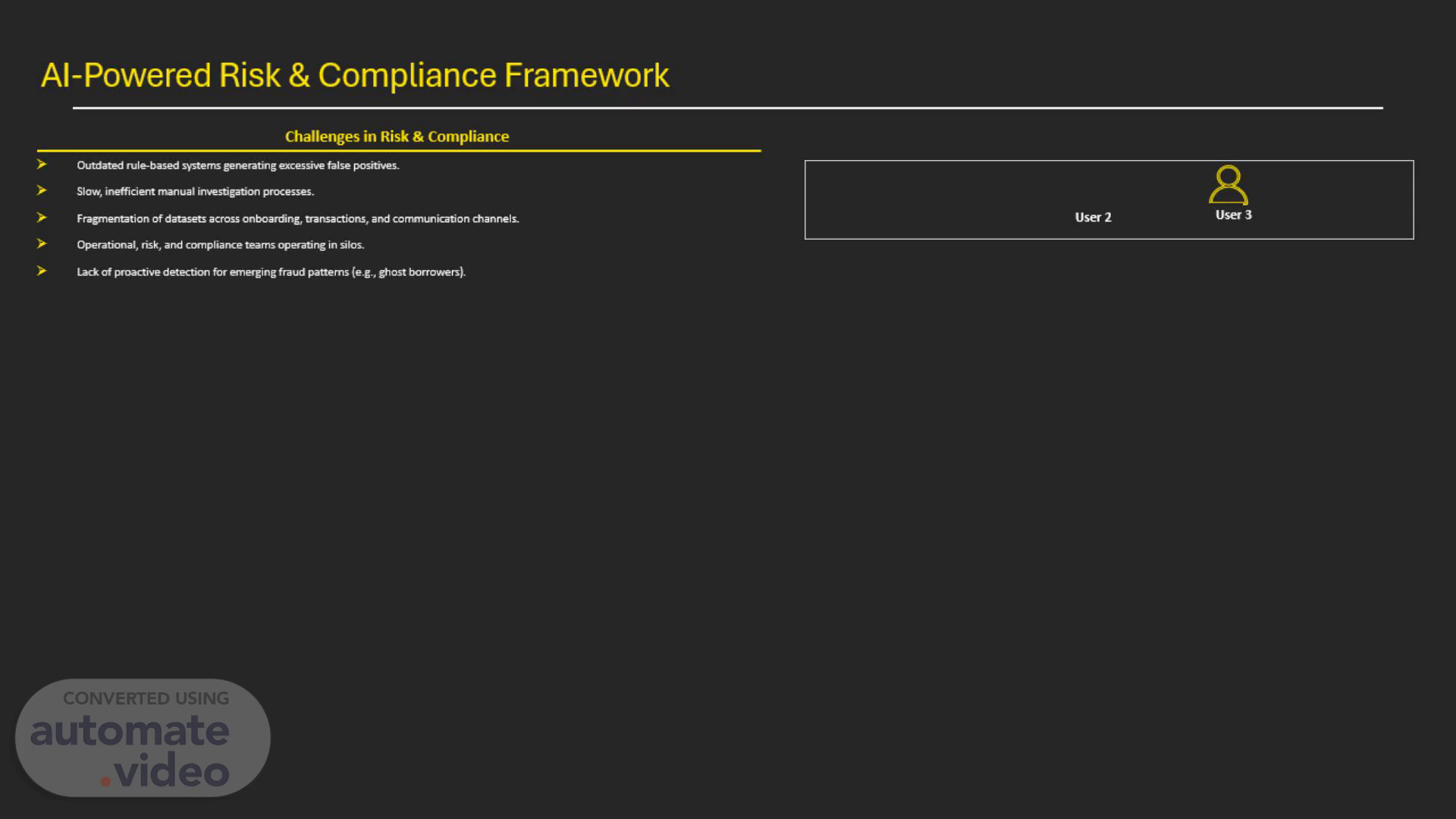Scene 1 (0s)
[Audio] Today, risk and compliance functions in financial institutions are facing a silent crisis not because of a lack of data, but because of how it's managed and interpreted. Imagine this: A risk analyst is flooded with alerts, 90% of which are false positives. Investigators spend hours, sometimes days, sifting through fragmented tools and isolated systems just to validate a single anomaly. Meanwhile, real threats slip through unnoticed. Let's talk about the five key challenges False Positives Overload Manual Bottlenecks Scattered Datasets Siloed Operations Lack of Proactive Intelligence And this brings us to the problem statement: Financial institutions are navigating a growing ocean of vast, diverse, and unstructured data using static, outdated systems. The result? High false positives, slow insights, and costly inefficiencies. That's exactly where our solution CRICS comes in..
Scene 2 (1m 19s)
[Audio] To address the challenges, we introduce 'CRICS' which stands for Cognitive Risk Intelligence & Control System. This AI-powered solution aims to digitally transform how financial institutions handle risk, compliance, and regulatory oversight. It brings together four intelligent components: Generative AI Agentic AI RAG And Multimodal Context Analysis Target industries for CRICS could be banking, insurance, fintech, investment firms, and regulatory bodies helping them move from reactive compliance to proactive risk management. With its scalable, explainable architecture and human-in-the-loop design, CRICS enhances operational efficiency, reduces risk exposure, and empowers smarter, faster decision-making..
Scene 3 (2m 19s)
[Audio] Welcome to the high-level architecture of CRICS. It starts with Data Ingestion, pulling in structured and unstructured data from various sources and validating it. Next, in the Data Processing layer, the system detects anomalies, violations, and policy breaches. Then, the Learning & Adaptation module uses feedback to continuously improve compliance models. At the core sits the AI Agent, leveraging large language models to reason, plan, and act on insights. Decisions move to the Orchestration Layer, where actions are executed via Compute and Distribution Engines. Finally, insights flow into intuitive dashboards and audit-ready reports. CRICS ensures traceability, adaptability, and real-time decision-making — all at scale.
Scene 4 (3m 13s)
[Audio] The CRICS architecture is divided into several key layers that work in concert: · Front-End Layer: This layer serves as the user interaction point, primarily through a Web Portal and user interfaces for Compliance Officers, Risk Analysts, and Investigators. · Application Layer: This is the core of the CRICS system, powered by Core AI Agents that are responsible for reasoning, planning, and acting. It includes a Reasoning Engine for contextual interpretation, leveraging Large Language Models (LLMs) such as GPT and BERT. A Knowledge Repository and a Vector Database are also present, which, along with text embedding models, support contextual policy retrieval and decision support for the LLMs. · Core Orchestration Engine: This component is central to managing the system's operations. It handles workflow control, task prioritization, and error handling, ensuring smooth execution of processes. · Planning Engine: This engine is responsible for decision orchestration and utilizes Dynamic Planning Models, including POMDP (Partially Observable Markov Decision Process) and MDP, to strategize actions. · Action Execution Layer: This layer facilitates the fulfilment of tasks through a Task Fulfilment Engine, which orchestrates API calls via API Orchestration Gateways. · Back-End Layer: This layer manages the routing of requests and includes a Distribution Engine with an API Gateway, Service Routing, and Load Balancer for efficient request handling. It also contains a Compute Engine responsible for LLM processing, model execution, and resource scaling. · CRICS AI Agents: These specialized agents perform various functions within the system: Data Ingestion Agent Learning and Adaption Agent Reporting Agent · Data Sources: CRICS can ingest data from various sources using protocols like Kafka, REST, ODATA, and SOAP. · API Interactions: The system communicates through various API response formats like REST, WEBSOCKET, GRAPHQL, JSON, and STREAM In essence, CRICS leverages powerful AI to automate and enhance compliance processes, but it is explicitly designed with human stakeholders at critical interaction points, ensuring that the system remains accountable, adaptable, and aligned with regulatory and ethical guidelines..
Scene 5 (6m 8s)
[Audio] Here's a quick look at the CRICS interface. The Overview Dashboard gives key metrics risks identified, controls applied, risk score, and AML hits. Ingestion & Processing shows data flow, failures, modes, and file queue all in one place for quick troubleshooting. The Regulations Hub centralizes documents, with source, dates, and changes plus AI-powered comparisons and simplified summaries of complex language. Risks & Issues Hub highlights risks by severity and area to support fast, informed decisions. These mocks were built in Firebase Studio using React, TypeScript, and JSON. The benefits? Proactive risk management, better efficiency, improved compliance, and continuous learning as AI adapts to new threats..
Scene 6 (7m 15s)
[Audio] Now, let's explore a use case related to a multinational bank is under regulatory scrutiny for missing suspicious transactions and delays in reporting. To address this, the bank adopts CRICS to enhance detection, monitor high-risk behavior, and streamline compliance. Challenges include outdated tools, too many false positives, and siloed operations. CRICS uses data lakes, generative AI, and regulatory APIs to unify data and automate workflows. The result: fewer false positives, faster SAR filings, and a stronger, adaptive AML framework ready for evolving risks..
Scene 7 (8m 24s)
[Audio] There are few potential future cases which discusses the implementation of an AI-driven system to combat ghost borrowers fictitious entities that secure loans without repayment intentions. Key objectives include enhancing credit risk scoring, proactively detecting fraud, and reducing financial losses. The system requires an existing credit framework, reliable data sources, and regulatory compliance. It involves multiple agents for data handling and decision-making, with strategies to mitigate bias and ensure data privacy. Overall, the initiative aims to strengthen the integrity of financial lending processes..
